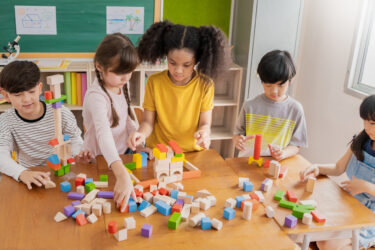Paints lost their punch? Crayons crumbling? When stocking art supplies for tots, remember that children make a lot more than just art – they make objects to extend their play, fantasy life and understanding of the world.
 Ann Sayre Wiseman, author of Making Things: A Handbook of Creative Discovery (Megan Tinley; $16.95) says kids make things in order to play and learn. Have a variety of versatile materials on-hand for kids to act when the inspiration strikes:
Ann Sayre Wiseman, author of Making Things: A Handbook of Creative Discovery (Megan Tinley; $16.95) says kids make things in order to play and learn. Have a variety of versatile materials on-hand for kids to act when the inspiration strikes:
Paper with pizzazz: Add variety to your paper shelf. Brightly-colored printer paper is great for crafts. Card stock in a variety of colors and weights, colored index cards, and big rolls of colored and white paper are enticing. Don’t overlook unused wrapping papers – most have a white side!
Fabric remnants and felt: Inexpensive scraps are available at fabric stores or can be made from old shirts, torn jeans, etc. Kids love the soft texture of felt, and it doesn’t fray. Use for puppets, dolls and for decorating other crafts.
Air-dry clay: Air-dry clay is inexpensive and requires no baking or firing. The clay dries hard and takes almost any kind of finish. In addition to making coil pots and other common pottery projects, kids can fashion figures to populate a fantasy world, make their own game pieces, create objects for dolls to use and a thousand other things.
Magic Nuudles: These look like colorful Styrofoam packing noodles, but are made of corn starch and are completely biodegradable. When you roll them on a wet sponge, they stick together. Very quickly, kids can create large and fairly durable objects. The bright colors give anything kids make a wacky, Willy-Wonka cheerfulness.
Photos: Let kids tear out interesting photos and ads just before you recycle your magazines and store them in a file folder. Your kids will have a great collection for making collages, illustrating homemade books, making faces and outfits for paper dolls and many more projects.
Round things collection: It’s hard to draw a perfect circle! Collect paper or disposable plastic plates and bowls, lids from yogurt containers, tops from two-liter bottles, thread spools and cardboard tubes.
Aluminum foil: Making things look shiny and metallic is important in robot making and other common kid-pursuits. Remove the serated edge and let your children use kid-friendly scissors to cut. Foil can be crumpled and sculpted.
Imagination: Kids are often inspired by odds and ends they can find in nature. Any new thing you bring into the house, the kids will want to use, and it will make their art more interesting.
Karen Cole, Ph.D., publishes Big Learning News (biglearning.com). She also spearheads parenting workshops.




